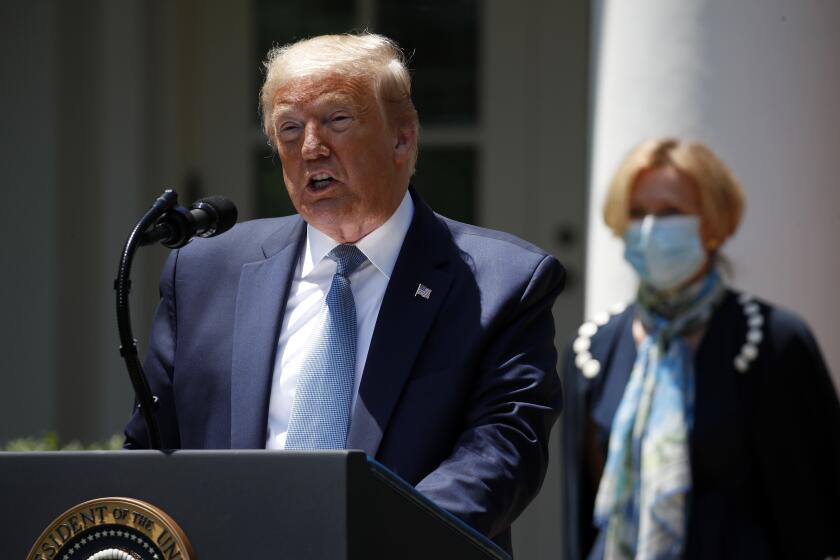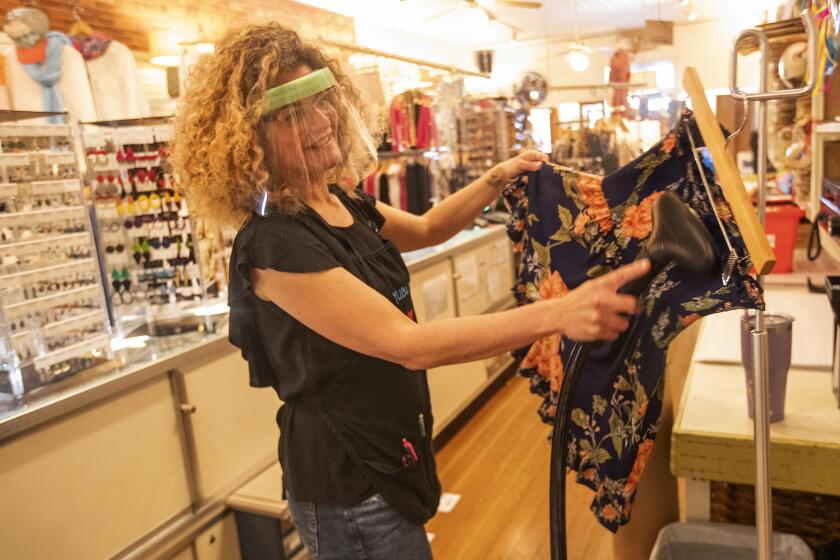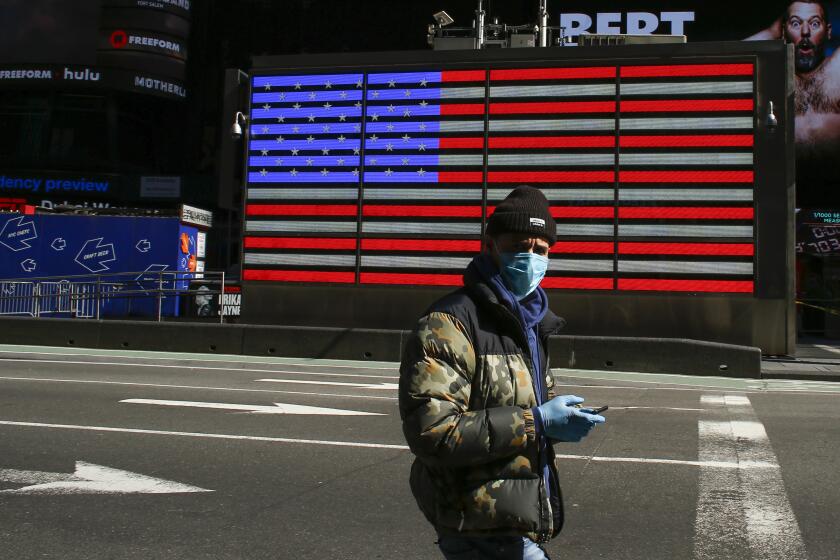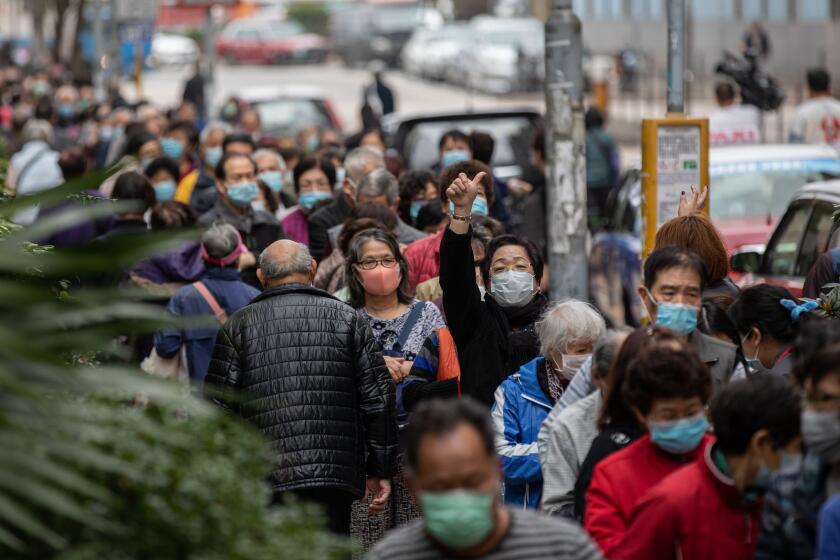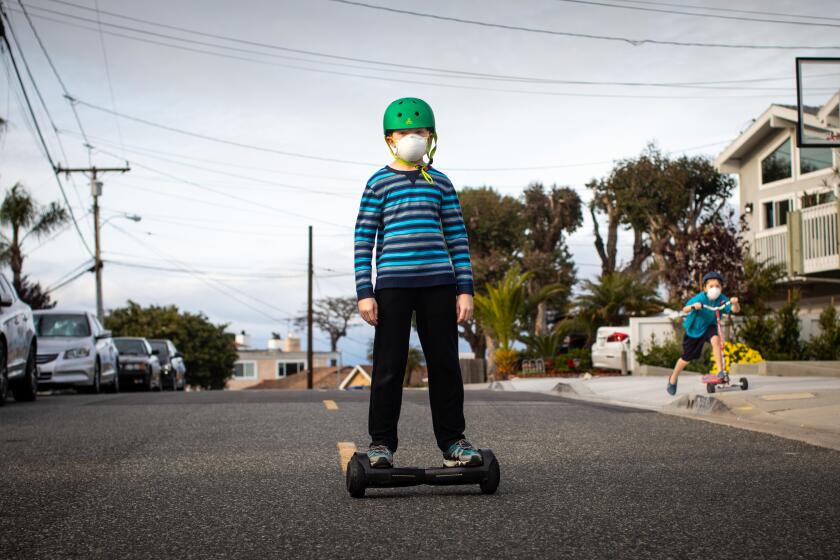Some shun wearing masks even though they’re essential coronavirus protection
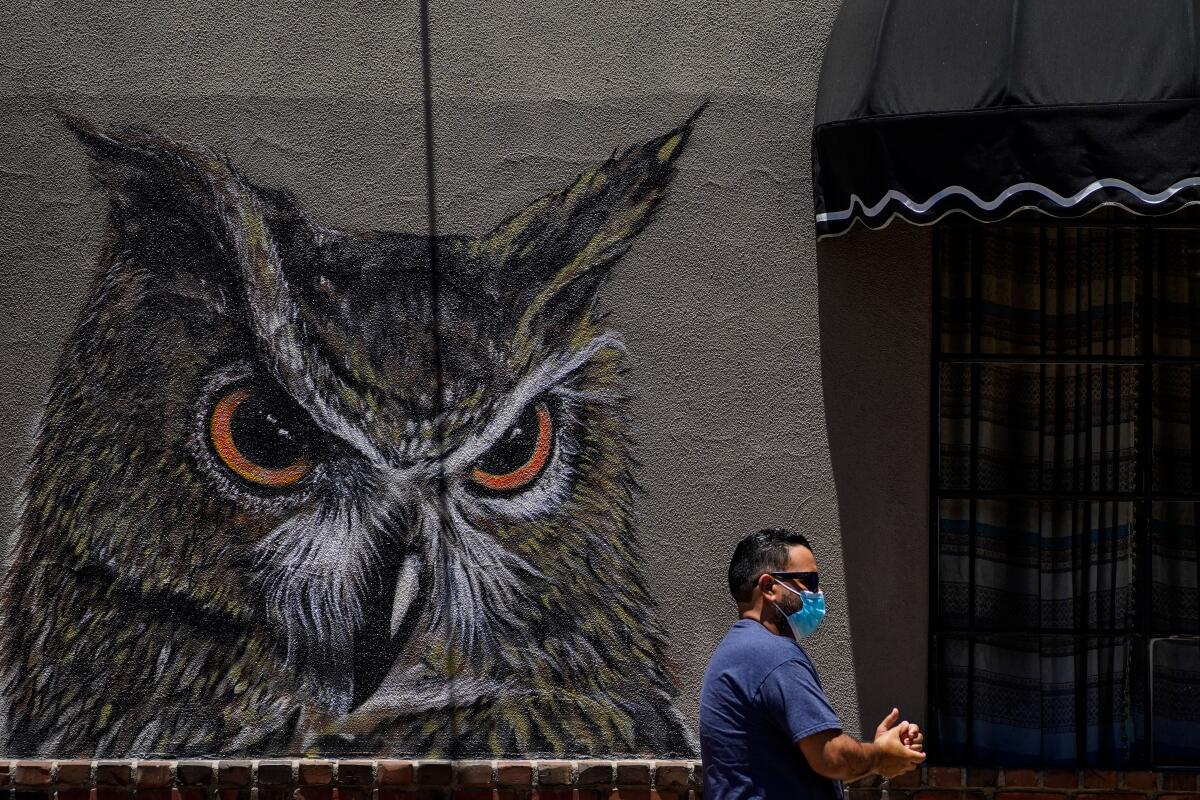
- Share via
Wearing masks should not be a contentious political issue, some public health experts say. In places like Japan, Hong Kong and Taiwan, universal mask wearing is credited with helping prevent an out-of-control spread of the coronavirus.
Yet, in California the idea of mandatory face coverings has become the subject of an intense political fight in areas , from Southern California to the Central Valley.
Dr. Nichole Quick, who resigned as Orange County health officer this week, became the latest victim of the fight after receiving a death threat and being targeted by anti-mask protesters who showed up at a public meeting displaying Quick’s photo with a Hitler mustache and swastikas.
Under intense pressure from the Orange County Board of Supervisors, her interim replacement, Dr. Clayton Chau, who is also the county’s Health Care Agency director, on Thursday rescinded Quick’s mandatory face mask order and said Orange County instead “strongly recommends” wearing masks in public settings.
Yet, as the U.S. death toll climbs past 114,000, some of the nation’s top infectious disease and epidemiology experts say moving away from universal mask wearing — one of the only tools we have against the coronavirus until a vaccine is available — will only frustrate society’s efforts to reopen.
“It’s the only way we get back to work — it’s to mask,” said Dr. Kirsten Bibbins-Domingo, chair of UC San Francisco’s Department of Epidemiology and Biostatistics. “All of the data tells us ... it’s pretty clear that masking is the element that changes the trajectories of the COVID pandemic.
“Literally, the only way we open up — which all of us want to do — is put on a mask,” Bibbins-Domingo said.
These days, the simple act of wearing a mask -- or not -- has devolved into partisan debate not just in the U.S. but in other countries as well.
She said it’s no coincidence that some countries where universal masking has long been culturally accepted have been hit less hard by the pandemic. “I don’t think there’s any doubt about it,” she said.
In these countries, residents have been spared the most severe stay-at-home orders or have moved out of that phase more quickly. “They haven’t seen large spikes because there’s a strong universal masking culture,” Bibbins-Domingo said.
Orange County Board of Supervisors Chair Michelle Steel condemned what she deemed to be a death threat against County Health Officer Dr. Nichole Quick this week.
A new study adds even more weight to the suspicions of experts that masks are playing an important role in controlling the spread of COVID-19. Social distancing, quarantine and isolation aren’t enough, the researchers found.
The report in the Proceedings of the National Academy of Sciences found that, while a stay-at-home order that went into effect in New York on March 22 did slow the daily increase in new infections in New York City, it was a mandatory mask wearing order that went into effect April 17 that finally caused new infections to decline, at a rate of about 3% a day.
The same pattern was seen in Italy, which announced a national lockdown on March 9 but didn’t impose a face covering rule in the nation’s hard-hit northern region until April 6. Again, researchers saw a difference in new daily cases after the mandatory mask rule was put in place.
“Hence, the difference made by implementing face covering significantly shapes the pandemic trends worldwide,” said the researchers, who are affiliated with Texas A&M University, the University of Texas at Austin, Caltech and UC San Diego.
The authors concluded that “wearing of face masks in public corresponds to the most effective means to prevent interhuman transmission.”
They added: “This inexpensive practice, in conjunction with simultaneous social distancing, quarantine, and contact tracing, represents the most likely fighting opportunity to stop the COVID-19 pandemic.”
There’s a global shortage of COVID-19 face masks — so people around the world are getting creative in making their own.
There are other studies that back up the importance of mask wearing. A recent study out of Germany found that face masks reduced the daily growth rate of reported infections by around 40%. In a British study, mathematical models found that wearing face masks all the time while in public — and not just after symptoms appear — would reduce the number of people with active infections over time.
“If widespread face mask use by the public is combined with physical distancing and some lockdown, it may offer an acceptable way of managing the pandemic and reopening economic activity long before there is a working vaccine,” the lead author of the British study, Richard Stutt of the University of Cambridge, said in a statement.
As more states reopen their economies, officials say fighting the coronavirus outbreak means wearing a face covering. But some are balking at restrictions.
In anecdotal evidence from the U.S., no customers of a salon in Missouri became infected with the virus, even though two hairstylists were sick — and scientists think it was because the hairstylists were wearing face masks.
Health experts are increasingly saying the U.S. authorities erred in the early weeks of the pandemic in discouraging the use of masks by healthy people.
The message was “they don’t work, when, in fact, what we meant to say was, ‘We don’t have enough masks. And we need to give them to people like healthcare workers,’” Bibbins-Domingo said. “That was a mistake.”
Some experts in the early days of the pandemic also emphasized what we didn’t know about masks’ usefulness. For one, there was much attention paid to the idea that masks alone are not particularly effective in preventing infection for the wearer, in part because they don’t protect the eyes; and because masks are itchy and will cause people to touch their faces.
Virtually the entire population of Hong Kong wore masks voluntarily from the beginning. They have had four COVID deaths.
But even in late March, other experts started to suspect that early success in keeping a lid on the coronavirus in Taiwan and Singapore was partly due to universal mask wearing, a legacy of the SARS outbreak from 2003.
“If you go to Taiwan or Singapore, everyone’s got a mask on all the time — healthy or not, sick or not,” Dr. Otto Yang, a UCLA expert on infectious disease, said in an interview in late March. “That’s probably been an important thing in other countries’ flattening their curve or preventing, containing infection.”
Now, some experts say masks are more important than social distancing.
“They’re both important — don’t get me wrong. If I had to choose one over another, ... I’d choose masks,” Dr. George Rutherford, a UC San Francisco epidemiologist and infectious-diseases expert, said at a campus webinar in May.
“Remember, what we’re trying to do here is prevent people who are asymptomatically infected from transmitting. So it’s about ... keeping your virus to yourself,” Rutherford said.
The U.S. Centers for Disease Control and Prevention estimates that 20% to 50% of everyone who gets infected by the coronavirus will remain asymptomatic yet may be just as contagious as people who are visibly ill.
Those who do end up becoming visibly sick are also actually highly contagious two or three days before they develop their first symptoms, Yang said Thursday.
“Everyone should really assume that they’re infected and wear face masks to protect the people around them,” Yang said. “It’s really kind of a public-minded thing to wear face masks for general protection of the public.”
There are some unfounded theories floating around, such as one that face coverings pose a danger to people’s oxygen levels. Cloth face masks and surgical masks do not pose such a threat, experts say, noting that many people who work in hospitals wear them all the time.
“No, there’s nothing to that. There’s all sorts of conspiracy theories about low oxygen and high CO2 levels,” Yang said. “It’s really not an issue.”
In California, which has reported more than 140,000 coronavirus infections and almost 5,000 deaths, whether mandatory mask orders are controversial seems to depend on the region. Mandatory masks have not been controversial in the two highly populated areas of California — Los Angeles County and the San Francisco Bay Area.
But mandatory mask laws have triggered opposition in other parts of Southern California and the Central Valley. Fresno County had a face mask rule for less than a day before it was pulled back. Riverside and San Bernardino counties lifted their orders after blowback. Stockton’s mayor, Michael Tubbs, proposed face covering rules but failed to get any support from the City Council.
Of California’s 15 most populous counties, those requiring the wearing of masks in public are: Los Angeles, San Diego, Santa Clara, Alameda, Sacramento, Contra Costa, San Francisco and San Mateo. Those that do not require masks in public are Orange, Riverside, San Bernardino, Fresno, Kern, Ventura and San Joaquin.
Among officials who have decided not to implement mandatory mask rules are Dr. Robert Levin, the Ventura County health officer. Levin said in April that he concluded that masks were not entirely effective, but added that he could change his mind “if the prevalence of disease increases in our county or some convincing evidence comes along.”
In Riverside County, elected officials last month voted to instruct their health officer to rescind the mandatory mask rule, saying people should make up their own minds whether to wear one. “People are smart enough to make [that] decision themselves,” Supervisor Jeff Hewitt said.
Some counties on California’s Central Coast have mandatory mask rules, like Santa Barbara, Monterey and San Benito, but San Luis Obispo County does not have such a rule.
“There is no incontrovertible, compelling or even a preponderance of evidence to support an order to wear a cloth mask in the community setting at this time,” Dr. Penny Borenstein, the health officer for San Luis Obispo County, wrote on May 3.
A pediatrician offers tips on how to help kids understand the need for face masks due to COVID-19.
Some sparsely populated counties also have implemented mandatory mask orders, including Mono and Inyo counties in the eastern Sierra; counties north of the Bay Area, like Mendocino, Lake, Plumas and Del Norte; Imperial County east of San Diego; and other counties around and near the Sacramento region, including Sutter, Yolo, Yuba and Sierra.
The Orange County Medical Assn. this week called Quick’s resignation a “dangerous precedent that should concern all of us,” and that “we must ... not allow bullying to drive the health recommendations that can keep us safe and healthy.”
“This public health crisis is not over. As we begin to reopen our county, the science is clear: Wearing a face covering can help slow the spread of this deadly virus,” Dr. Diana Ramos, president of the Orange County Medical Assn., said in a statement.
“We were absolutely appalled ... that a public servant is getting literally death threats to her and her family, and she has three small children,” said the medical association’s executive director, Jim Peterson. He said he was worried that some customers may start to refuse wearing masks in stores without the mandatory order.
“It’s going to cause a lot of problems in our community,” Peterson said. “The only thing we have as any kind of barrier to slow down the transmission of COVID is wearing a mask and social distancing. That’s all we’ve got right now. And it worked. There’s no doubt about it.”
Peterson said the coronavirus is still as dangerous as it was months ago. “It’s still there. It’s still contagious. It’s still a very deadly virus to a lot of different types of people.”
Times staff writers Kailyn Brown, Hannah Fry, Melissa Gomez, Stephanie Lai and Luke Money contributed to this report.
More to Read
Sign up for Essential California
The most important California stories and recommendations in your inbox every morning.
You may occasionally receive promotional content from the Los Angeles Times.
